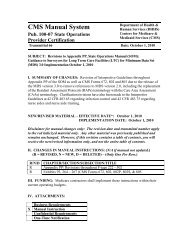2003 Louisiana Vital Statistics Report - Louisiana Department of ...
2003 Louisiana Vital Statistics Report - Louisiana Department of ...
2003 Louisiana Vital Statistics Report - Louisiana Department of ...
You also want an ePaper? Increase the reach of your titles
YUMPU automatically turns print PDFs into web optimized ePapers that Google loves.
<strong>2003</strong> LOUISIANA VITAL STATISTICS REPORT POPULATION<br />
INTRODUCTION<br />
Use <strong>of</strong> Population Data in <strong>Vital</strong> Event Surveillance<br />
Simple counts <strong>of</strong> information collected on vital certificates or forms are helpful in planning provisions for health services since<br />
they document the number <strong>of</strong> people who experience health events in a particular geographic area.<br />
When questions concerning comparisons between population groups arise, however, simple counts are <strong>of</strong>ten misleading<br />
because they do not account for differences in the composition <strong>of</strong> the groups. For example, more people die in towns where the<br />
majority <strong>of</strong> the inhabitants are elderly than in towns with a majority <strong>of</strong> young adults, simply because older people die more <strong>of</strong>ten<br />
than younger people do. Solely relying on counts as a measure <strong>of</strong> the magnitude <strong>of</strong> the vital event would deceptively imply that<br />
the town with a greater majority <strong>of</strong> elderly people has an abnormally high occurrence <strong>of</strong> death. Statisticians calculate rates in<br />
order to address these and other concerns related to the comparison <strong>of</strong> groups within a population. Rates provide a way to<br />
relate the number <strong>of</strong> events that occurred to the population in which they occurred. They are calculated by dividing the number<br />
<strong>of</strong> events by the number <strong>of</strong> people in the group, then multiplying the quotient by an appropriate enlarging factor (typically 1,000<br />
or 100,000) to provide an understandable integer. As is <strong>of</strong>ten the case, when the number <strong>of</strong> individuals in a group where the<br />
event occurred is not known, census population data are used to estimate the number.<br />
<strong>Louisiana</strong> population figures provide a frame <strong>of</strong> reference for examining the vital events that occur within the resident population<br />
within a particular year. State population figures are used to calculate the overall rates at which births and deaths occur<br />
throughout the state.<br />
Source <strong>of</strong> Data: <strong>2003</strong> estimate from United States Bureau <strong>of</strong> Census<br />
For the years that fall between the ten-year census counts, intercensal population estimates are calculated by the United States<br />
Census Bureau. These estimates <strong>of</strong> yearly populations are based on determinations <strong>of</strong> the number <strong>of</strong> births, deaths, and<br />
migrations into and out <strong>of</strong> the state on an annual basis.<br />
Detailed intercensal estimates for <strong>2003</strong> were calculated based on data provided by the U.S. Bureau <strong>of</strong> the Census in their<br />
Bridged-Race Postcensal Population Estimates <strong>2003</strong>. Data from the same source were used in the calculation <strong>of</strong> rates in this<br />
report.<br />
Population Estimates<br />
The <strong>2003</strong> US Census estimate placed the number <strong>of</strong> <strong>Louisiana</strong> residents at 4,496,334. Historical estimates <strong>of</strong> the total <strong>Louisiana</strong><br />
population are shown in Table 1.1.<br />
Estimates grouped by sex, race, and age describe the population’s composition and are used to calculate rates for comparison<br />
<strong>of</strong> vital events among population subgroups (Table 1.2). The approximately equivalent <strong>2003</strong> estimates were used for calculation.<br />
__________________________________________________________________________________________________________________<br />
<strong>Louisiana</strong> Office <strong>of</strong> Public Health, State Center for Health <strong>Statistics</strong> Page 9
















